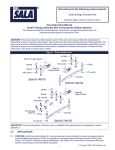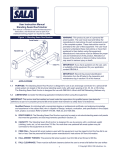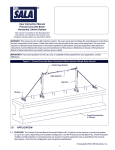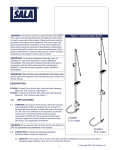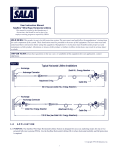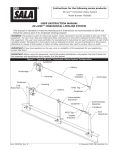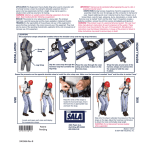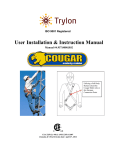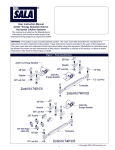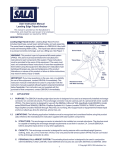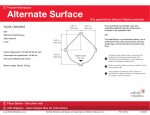Download User Instruction Manual Static Rope Grab for 3/8
Transcript
User Instruction Manual Static Rope Grab for 3/8 Inch Wire Rope This manual is intended to be used as part of an employee training program as required by OSHA. © Copyright 2003, DB Industries, Inc. Figure 1 - 5000338 Static Rope Grab for Wire Rope Detent Pin Wedge/Handle Assembly ID Label Attachment D-ring Lifeline WARNING: This product is part of a personal fall arrest or restraint system. The user must follow the manufacturer’s instructions for each component of the system. These instructions must be provided to the user of this equipment. The user must read and understand these instructions before using this equipment. These instructions must be followed for proper use and maintenance of this equipment. Alterations or misuse of this equipment, or failure to follow instructions, may result in serious injury or death. IMPORTANT: If you have questions on the use, care, or suitability of this equipment for your application, contact DBI/SALA. IMPORTANT: Record the product identification information from the ID label in the inspection and maintenance log in section 9.0 of this manual. 2 1.0 1.1 APPLICATIONS PURPOSE: This rope grab is intended to be used as part of a personal fall arrest system or restraint system. See Figure 2. The rope grab provides a portable lanyard connection point on a wire rope lifeline. Note: This rope grab is not designed to follow the worker. If repositioning on your lifeline is required, you must manually reposition the rope grab at the desired location. Figure 2 - Applications FALL ARREST: The rope grab is used as part of a personal fall arrest system. Personal fall arrest systems typically include a rope grab, lifeline, connecting subsystem (lanyard ), and full body harness. Maximum permissible free fall is six feet. RESTRAINT: The rope grab is used as part of a restraint system. Restraint systems typically include a rope grab, lifeline, connecting subsystem (lanyard), and full body harness. No vertical free fall is permitted. 1.2 LIMITATIONS: Consider the following application limitations before using this equipment: CAPACITY: This equipment is designed for use by persons with a combined weight (clothing, tools, etc.) of no more than 310 lbs. FREE FALL: Free fall must be limited to six feet. See subsystem manufacturer’s instructions for more information. FALL CLEARANCE: There must be sufficient clearance below the worker to arrest a fall before striking the lower level or obstruction. See section 3.0 for required clearance information. 3 SWING FALLS: See Figure 3. Swing falls occur when the anchorage point is not directly overhead. The force of striking an object in a swing fall may cause serious injury or death. Minimize swing falls by working as directly below the anchorage point as possible. Do not permit a swing fall if injury could occur. Swing falls will significantly increase the clearance required when a self retracting lifeline or other variable length connecting subsystem is used. If a swing fall situation exists in your application, contact DBI/SALA before proceeding. Figure 3 - Swing Fall Hazard ENVIRONMENTAL HAZARDS: Use of this equipment in areas where environmental hazards exist may require additional precautions to reduce the possibility of injury to the user or damage to the equipment. Hazards may include, but are not limited to: high heat, caustic chemicals, corrosive environments, high voltage power lines, explosive or toxic gases, moving machinery, or sharp edges. COMPATIBILITY: The rope grab must be used with components and subsystems that meet the requirements specified in section 2.0. LANYARD LENGTH: The lanyard length must be limited to four feet or less. TRAINING: This equipment is intended to be used by persons trained in its application and use. 1.3 2.0 2.1 APPLICABLE STANDARDS: Refer to applicable local, state, and federal requirements governing this equipment for more information on rope grabs and associated system components, including OSHA 1910.66, appendix C. SYSTEM REQUIREMENTS COMPATIBILITY OF COMPONENTS AND SUBSYSTEMS: This rope grab is designed for use with DBI/SALA approved components and subsystems only. Substitutions or replacements made with nonapproved components or subsystems may jeopardize compatibility of 4 equipment and may effect the safety and reliability of the complete system. If you have questions regarding compatibility of components or subsystems, contact DBI/SALA. 2.2 COMPATIBILITY OF CONNECTORS: Connectors are considered to be compatible with connecting elements when they have been designed to work together in such a way that their sizes and shapes do not cause their gate mechanisms to inadvertently open regardless of how they become oriented. Contact DBI/SALA if you have any questions about compatibility. Connectors (hooks, carabiners, and D-rings) must be capable of supporting at least 5,000 lbs. (22kN). Connectors must be compatible with the anchorage or other system components. Do not use equipment that is not compatible. Non-compatible connectors may unintentionally disengage. See Figure 4. Connectors must be compatible in size, shape, and strength. Self locking snap hooks and carabiners are required by ANSI Z359.1 and OSHA. Figure 4 - Unintentional Disengagement (Roll-out) If the connecting element that a snap hook (shown) or carabiner attaches to is undersized or irregular in shape, a situation could occur where the connecting element applies a force to the gate of the snap hook or carabiner. This force may cause the gate (of either a self-locking or a non-locking snap hook) to open, allowing the snap hook or carabiner to disengage from the connecting point. Small ring or other non-compatibly shaped element 1. Force is applied to the snap hook. 2.3 2. The gate presses against the connecting ring. 3. The gate opens allowing the snap hook to slip off. MAKING CONNECTIONS: Only use self-locking snap hooks and carabiners with this equipment. Only use connectors that are suitable to each application. Ensure all connections are compatible in size, shape and strength. Do not use equipment that is not compatible. Ensure all connectors are fully closed and locked. 5 DBI/SALA connectors (snap hooks and carabiners) are designed to be used only as specified in each product’s user’s instructions. See Figure 5 for inappropriate connections. DBI/SALA snap hooks and carabiners should not be connected: A. To a D-ring to which another connector is attached. B. In a manner that would result in a load on the gate. NOTE: Large throat opening snap hooks should not be connected to standard size D-rings or similar objects which will result in a load on the gate if the hook or D-ring twists or rotates. Large throat snap hooks are designed for use on fixed structural elements such as rebar or cross members that are not shaped in a way that can capture the gate of the hook. C. In a false engagement, where features that protrude from the snap hook or carabiner catch on the anchor and without visual confirmation seems to be fully engaged to the anchor point. D. To each other. E. Directly to webbing or rope lanyard or tie-back (unless the manufacturer’s instructions for both the lanyard and connector specifically allow such a connection). F. To any object which is shaped or dimensioned such that the snap hook or carabiner will not close and lock, or that roll-out could occur. Figure 5 - Inappropriate Connections 6 2.4 ANCHORAGE STRENGTH: The anchorage strength required is dependent upon the application: FALL ARREST: From OSHA 1910.66 and 1926.500: Anchorages used for attachment of a personal fall arrest system shall be independent of any anchorage being used to support or suspend platforms, and be capable of supporting at least 5,000 lbs. per user attached, or be designed, installed, and used as part of a complete personal fall arrest system which maintains a safety factor of at least two, and is supervised by a qualified person. RESTRAINT: Anchorages must be capable of supporting a minimum of 3,000 lbs. per system attached to the anchorage. WARNING: Restraint anchorages may only be used where there is no possible vertical free fall. Restraint anchorages do not have sufficient strength for fall arrest. Do not connect personal fall arrest systems to restraint anchorages. 2.5 LIFELINES: DBI/SALA offers lifeline assemblies cut to your specified length. If supplying your own lifeline, only use 3/8-inch diameter, 7x19, galvanized steel aircraft cable, 14,400 lbs. minimum breaking strength, per military specification MIL-W-83420 or MIL-W-1511. Lifeline assemblies must have a minimum breaking strength of 5,000 lbs. WARNING: Lifelines used with this rope grab must meet the size, construction, material properties, and specifications stated above. 2.6 LANYARD: The lanyard length must be limited to four feet or less. For personal fall arrest systems, DBI/SALA recommends using an energy absorbing lanyard with self locking snap hooks. The energy absorbing lanyard must limit fall arrest forces to 1,800 lbs. or less. Lanyards labeled with ANSI A10.14, Type II, must not be used for fall arrest applications. All lanyards must have a minimum breaking strength of 5,000 lbs. 2.7 BODY SUPPORT: For fall arrest applications, a full body harness must be used. Although DBI/SALA does not recommend it’s use, a body belt may be used for restraint applications. 3.0 OPERATION AND USE WARNING: Do not alter or intentionally misuse this equipment. Consult DBI/ SALA when using this equipment in combination with components or subsystems other than those described in this manual. Some subsystem and component combinations may interfere with the operation of this equipment. 7 WARNING: Consult your doctor if there is reason to doubt your fitness to safely absorb the shock from a fall arrest. Age and fitness seriously affect a worker's ability to withstand falls. Pregnant women or minors must not use DBI/SALA self retracting lifelines. 3.1 BEFORE EACH USE carefully inspect the rope grab according to section 5.0. 3.2 PLAN your system before using this equipment. Consider all factors that will affect your safety during use of this equipment. Consider the following points when planning your system: ANCHORAGE: Select a rigid anchorage point that is capable of sustaining the required loads. See section 2.4. Carefully select the anchorage location to minimize free fall and swing fall hazards. For personal fall arrest systems, OSHA requires that the anchorage be independent of the means suspending or supporting the user. For restraint systems, the anchorage must be located such that no vertical free fall is possible. FREE FALL: Never work above your anchorage point. Position the rope grab as far up the lifeline as possible to limit your free fall. Personal fall arrest systems must be rigged to limit free fall distance to six feet. Restraint systems must be rigged such that there is no possible vertical free fall. FALL ARREST FORCES: The personal fall arrest system must limit fall arrest forces to 1,800 lbs. or less. FALL CLEARANCE: There must be sufficient clearance in your fall path to prevent striking an object or the lower level in the event of a fall. The amount of clearance required is dependent upon the application. See Figure 6 to estimate your required fall clearance. WARNING: Ensure the design of your worksite and your working location will allow the rope grab to remain locked on the lifeline when a fall occurs. When a fall occurs, the lanyard must pull the attachment D-ring on the rope grab down to lock the rope grab onto the lifeline. SHARP EDGES: Avoid working where parts of the system will be in contact with, or abrade against unprotected sharp edges. SLOPED ROOF: When using this rope grab on a sloped roof, access to roof edges and corners must be limited with guardrails, warning lines, or monitors. Keep your lanyard length as short as possible. 8 Figure 6 - Clearance Requirements GENERAL USE CONSIDERATIONS: Avoid working where your lifeline may cross or tangle with that of another worker. Do not allow your lanyard to pass under your arms or between your feet. Do not clamp, tie, or otherwise prevent the rope grab from locking. WARNING: The rope grab handle must not be prevented from locking onto the lifeline by interference from objects, or be held open by hand when in use. Failure to heed this warning may result in serious injury or death. AFTER A FALL: Components which have been subjected to the forces of arresting a fall must be removed from service and destroyed. RESCUE: The employer must have a rescue plan in place when using this equipment. The employer must have the ability to perform a rescue quickly and safely. 9 3.3 MAKING CONNECTIONS: ATTACHING THE ROPE GRAB TO THE LIFELINE: Step 1 Step 1. Up Arrow Hold the rope grab in the up position, as indicated by an arrow stamped on the rope grab body. Step 2 Remove Detent Pins Step 2. Open the rope grab by pressing the button on both detent pins and pulling the detent pins out of the rope grab. Step 3. Place the rope grab body around the lifeline, ensuring the stamped arrow is pointing up. Install the upper detent pin. Step 3 Place Rope Grab around Lifeline Step 4. Install upper Detent Pin Install the wedge/ handle assembly into the rope grab by positioning the slot in the wedge around the upper detent pin and against the lifeline. Step 4 Place slot in Wedge around upper Detent Pin 10 Step 5. Rotate the bottom end of the wedge/handle assembly into the rope grab until the hole in the handle aligns with the lower hole in the rope grab body. Install the lower detent pin. Step 5 Install lower Detent Pin Align hole in Handle with hole in Body Step 6. Ensure the detent pins are securely locked. Check the locking action by lifting the handle up and releasing. The rope grab must lock onto the lifeline. If the rope grab does not securely lock on the lifeline, repeat steps 1 through 5. Do not use if the rope grab will not operate correctly. CONNECTING THE LANYARD TO THE BODY SUPPORT: See Figure 7 Attach your lanyard to the rope grab D-ring. When using an energy absorbing lanyard, the pack end of the lanyard is attached to the back D-ring on your body harness. When using a body belt (for restraint applications only) connect the restraint lanyard to the D-ring on your body belt. Ensure all connections are compatible. See lanyard and body support manufacturer’s instructions for more information. 3.4 Figure 7 - Connection POSITIONING THE ROPE GRAB ON THE LIFELINE: This rope grab is designed to remain in place on the lifeline. To reposition the rope grab on the lifeline, follow these steps: Step 1. Lift the rope grab handle up to release it from its current position. 11 Step 2. Raise or lower the rope grab to the new position. Position the rope grab at or above your back D-ring to minimize free fall distance. Step 3. To check the locking action of the rope grab, lift up the handle and release. The rope grab must lock onto the cable. If the rope grab does not operate correctly, repeat attachment steps listed in section 3.3. WARNING: Rope grab attachment and positioning procedures must be followed. Improper attachment may cause the rope grab to slip or unlock from the lifeline, which may result in serious injury or death. 4.0 4.1 TRAINING It is the responsibility of all users of this equipment to understand these instructions, and to be trained in the correct installation, use, and maintenance of this equipment. These individuals must be aware of the consequences of improper installation or use of this equipment. This user manual is not a substitute for a comprehensive training program. Training must be provided on a periodic basis to ensure proficiency of the users. IMPORTANT: Training must be conducted without exposing the trainee to a fall hazard. Training should be repeated on a periodic basis. 5.0 5.1 INSPECTION FREQUENCY: • Before Each Use: Inspect the rope grab according to the steps listed in section 5.2 and 5.3. • Annually: The rope grab must be inspected by a competent person other than the user at least annually. See sections 5.2 and 5.3 for inspection steps. WARNING: If the rope grab has been subjected to fall arrest or impact forces it must be removed from service and destroyed. IMPORTANT: Extreme working conditions (harsh environments, prolonged use) may require increasing the frequency of inspections. 5.2 INSPECTION: Step 1. Inspect the detent pins. The button should spring back when 12 pushed down. The pins should slide easily through the rope grab body and wedge/handle assembly. 5.3 Step 2. Inspect the function of the wedge/handle assembly. The handle should move freely, with no sticking or binding. The wedge must engage and lock onto the lifeline. The handle spring must be in place and undamaged. Step 3. Inspect the lanyard attachment D-ring. The D-ring must be free of corrosion, cracks, or other deformities. The bracket and pin holding the D-ring must be undamaged. Step 4. Inspect the rope grab body. The rope grab body must be free of wear, corrosion, cracks, or other deformities. Step 5. All labels and markings on the rope grab must be present and fully legible. See section 8.0. Step 6. Inspect the lifeline according to the manufacturer’s instructions. If inspection reveals an unsafe or defective condition, remove the rope grab from service and destroy it, or contact an authorized service center for repair. IMPORTANT: Do not alter or attempt to repair the rope grab. Do not make substitutions for the rope grab parts. Repairs may only be performed by an authorized service center. 6.0 MAINTENANCE, SERVICING, STORAGE 6.1 Periodically clean the rope grab using water and mild detergent. Clean the label as required. 6.2 Replacement parts and additional maintenance and servicing procedures must be completed by an authorized service center. An authorization and return number must be issued by DBI/SALA. 6.3 Clean and store system components according to the manufacturer’s instructions. 6.4 Store the rope grab in a clean and dry environment out of direct sunlight. Avoid areas with chemical vapors. Inspect the rope grab after extended storage. 13 7.0 7.1 SPECIFICATIONS SPECIFICATIONS: • Weight: 2.25 lbs. • Overall Dimensions (including detent pins): 10.5x2.5x5.5 inches. • Materials: Stainless steel. • Patent Numbers: U.S. patent numbers: 3,979,797; 4,071,926; Canadian patent numbers: 1,037,000; 1,052,340; 1,102,288. 7.2 PERFORMANCE DATA: • Arrest Force: Designed for 1,800 lbs. maximum arresting force. • Maximum Capacity: 310 lbs. • Applicable Standards: OSHA 1910.66, appendix C. 8.0 LABELING These labels and markings must be present and fully legible: Label and Markings (Rope Grab shown with Detent Pins removed for clarity) 14 9.0 INSPECTION AND MAINTENANCE LOG SERIAL NUMBER: ___________________________________________ MODEL NUMBER: ___________________________________________ DATE PURCHASED: _________________________________________ INSPECTION DATE INSPECTION ITEMS NOTED CORRECTIVE ACTION Approved By: Approved By: Approved By: Approved By: Approved By: Approved By: Approved By: Approved By: Approved By: Approved By: Approved By: Approved By: 15 MAINTENANCE PERFORMED USA Canada 3965 Pepin Avenue Red Wing, MN 55066-1837 Toll Free: 800-328-6146 Phone: (651) 388-8282 Fax: (651) 388-5065 www.salagroup.com 260 Export Boulevard Mississauga, Ontario L5S 1Y9 Toll Free: 800-387-7484 Phone: (905) 795-9333 Fax: (905) 795-8777 www.salagroup.com This instruction manual is available for download at www.salagroup.com. I S O 9001 Certificate No. FM 39709 Form: 5906265 Rev: D
















